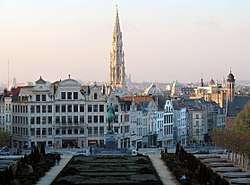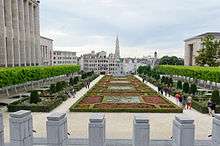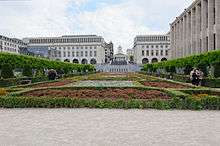Mont des Arts
| Mont des Arts (French) Kunstberg (Dutch) | |
|---|---|
 | |
| Location | Brussels, Belgium |
| Coordinates | 50°50′38″N 04°21′24″E / 50.84389°N 4.35667°ECoordinates: 50°50′38″N 04°21′24″E / 50.84389°N 4.35667°E |
| Built | 1954–1969 |
| Architect |
Maurice Houyoux, Jules Ghobert René Péchère (garden) |
| Architectural style(s) | Modernism |
| Designated | 18 November 1976 |
The Mont des Arts (French, pronounced [mɔ̃dɛzaʁ]) or Kunstberg (Dutch, pronounced [ˈkɵnzdbɛrx] (![]()
This site is located between rue Montagne de la Cour/Hofbergstraat and the Coundenberg in its 'upper' part, and Boulevard de l'Empereur/Keizerslaan and Place de l'Albertine/Albertinaplein in its 'lower' part. It is served by the Brussels Central Station.
History
The area of the Mont des Arts used to be a densely populated neighbourhood, the Quartier Saint Roches/Sint-Rochuswijk. Between the 15th and the 18th century, the hill on which it was located was known as the Montagne de la Cour/Hofberg.[1]
By the end of the 19th century, King Leopold II had the idea to convert the site into an arts' quarter and bought the whole neighbourhood. Various architects and urban planners were called upon to draw plans of the buildings which were to accommodate all kinds of cultural institutions. After the demolition of the old buildings, the site turned into an ugly urban void because the project lacked sufficient finance. To increase the area's appeal during the Brussels International Exposition of 1910, the king ordered the French landscape architect Pierre Vacherot to design a 'temporary' garden on the hill. It featured a park and a monumental staircase with cascading fountains descending the gentle slope from Place Royale down to Boulevard de l'Empereur/Keizerslaan.[1] In 1910, a year after the death of Leopold II, the new park was inaugurated by King Albert I.
Although the garden was conceived as temporary, it became a well-appreciated green area in the heart of the capital, but when the plans for the Mont des Arts came back by the end of the 1930s, this park had to be demolished to create a new square as the centre of the urban renewal project. The project was entrusted jointly to architects Maurice Houyoux and Jules Ghobert. Between 1956 and 1958, the park and its surroundings gave way to massive, severe geometric structures such as the Royal Royal Library of Belgium and the Congress Palace. The new geometric garden on the square was designed by landscape architect René Péchère.[1] The inauguration took place in 1969.
Present day
The Mont des Arts offers one of Brussels' finest views. From the elevated vantage point, the famous tower of the Brussels Town Hall in the Grand Place is clearly visible.[2] On a sunny day, the Koekelberg Basilica and even the Atomium can be seen.[3]
Major tourist attractions are located within walking distance of the Mont des Arts: the Musical Instrument Museum (MIM), the Royal Museums of Fine Arts, the Royal Palace, and the Cathedral of St. Michael and St. Gudula.
 The spire of the Brussels City Hall seen from the Mont des Arts/Kunstberg
The spire of the Brussels City Hall seen from the Mont des Arts/Kunstberg View of the garden of the Mont des Arts/Kunstberg
View of the garden of the Mont des Arts/Kunstberg Statue of King Albert I
Statue of King Albert I View of the fountains below the Congress Palace of Brussels
View of the fountains below the Congress Palace of Brussels.jpg) Garden of the Mont des Arts/Kunstberg during the nautical twilight
Garden of the Mont des Arts/Kunstberg during the nautical twilight
References
- 1 2 3 "Kunstberg - History". www.montdesarts.com. Retrieved 2018-06-09.
- ↑ "Mont des Arts Gardens". visit.brussels. Retrieved 2018-06-09.
- ↑ Poel, Nana Van De. "The History Of The Mont des Arts In 1 Minute". Culture Trip. Retrieved 2018-08-15.
External links
| Wikimedia Commons has media related to Kunstberg/Mont des Arts. |

